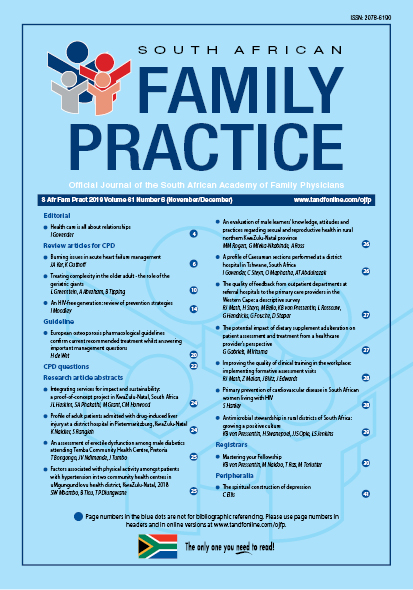Profile of adult patients admitted with drug-induced liver injury at a district hospital in Pietermaritzburg, KwaZulu-Natal
Abstract
Background: Drug-induced liver injury (DILI) can be prevented if diagnosed and treated timeously. The identification and primary prevention of DILI risk factors presents the rational means of reducing hospital costs and mortality.
Methods: A retrospective chart review was conducted of clinical in-patient records of all adult patients admitted to Northdale Hospital (NDH) with a diagnosis of DILI. Patients with pre-existing liver disease were excluded.
Results: A total of 95 patient files with DILI were reviewed. The burden of DILI at NDH over the two-year period was 0.19%. The average age was 38 years, with a slightly higher female preponderance (62.1%). A lower serum albumin level (mean 21.35 g/dl) was significantly associated with DILI (p < 0.001). Forty-six patients had a history of alcohol consumption, which increased the risk of DILI (OR 2.1). Of the patients reviewed, 62 (65%) were on antiretroviral therapy (ART) whereas 41 (43%) were on tuberculosis treatment (TBT) at presentation. The most common co-morbidities associated with DILI were HIV (75.7%), TB (43.2%), renal disease (34.7%) and malnutrition (31.6%). The most common hepatotoxins, apart from ART and TBT, were paracetamol (46.3%), cotrimoxazole (32.6%), alcohol (48.4%) and traditional medication (27.4%).
Conclusion: This study demonstrated associations with the development of DILI and being female gender, younger age group, hypoalbuminaemia and renal failure. The use of alcohol, traditional medication and the overzealous use and prescription of paracetamol to patients who present with DILI is concerning. The case fatality rate of 14.7% demonstrates the importance of identifying these potential risk factors timeously.
The full article is available at https://doi.org/10.1080/20786190.2019.1657323

